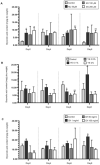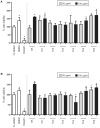Enhanced Production of Bryonolic Acid in Trichosanthes cucumerina L. (Thai Cultivar) Cell Cultures by Elicitors and Their Biological Activities
- PMID: 32498354
- PMCID: PMC7356870
- DOI: 10.3390/plants9060709
Enhanced Production of Bryonolic Acid in Trichosanthes cucumerina L. (Thai Cultivar) Cell Cultures by Elicitors and Their Biological Activities
Abstract
Bryonolic acid is a triterpenoid compound found in cucurbitaceous roots. Due to its biological activities, this compound gets more attention to improve production. Herein, we carried out efficient ways with high bryonolic acid productions from Trichosanthes cucumerina L., a Thai medicinal plant utilizing plant cell cultures. The results showed that calli (24.65 ± 1.97 mg/g dry weight) and cell suspensions (15.69 ± 0.78 mg/g dry weight) exhibited the highest bryonolic acid productions compared with natural roots (approximately 2 mg/g dry weight). In the presence of three elicitors (methyl jasmonate, yeast extract, and chitosan), cell suspensions treated with 1 mg/mL of chitosan for eight days led to higher bryonolic acid contents (23.56 ± 1.68 mg/g dry weight). Interestingly, cell culture and root extracts with high bryonolic acid contents resulted in significantly higher percent cell viabilities than those observed under control (1% v/v DMSO) treatment in Saos-2 and MCF-7 cells. The present study indicated that T. cucumerina L. cell cultures are alternative and efficient to produce the biologically important secondary metabolite.
Keywords: Trichosanthes cucumerina L.; bryonolic acid; callus; cell suspension; elicitors.
Conflict of interest statement
The authors declare no conflict of interest.
Figures





Similar articles
-
De novo transcriptome analysis and identification of candidate genes associated with triterpenoid biosynthesis in Trichosanthes cucumerina L.Plant Cell Rep. 2021 Oct;40(10):1845-1858. doi: 10.1007/s00299-021-02748-8. Epub 2021 Jul 6. Plant Cell Rep. 2021. PMID: 34228189
-
Cytotoxic properties of root extract and fruit juice of Trichosanthes cucumerina.Planta Med. 2009 Jun;75(8):839-42. doi: 10.1055/s-0029-1185455. Epub 2009 Mar 13. Planta Med. 2009. PMID: 19288406
-
Cytotoxic activity of bryonolic acid isolated from transformed hairy roots of Trichosanthes kirilowii var. japonica.Biol Pharm Bull. 1995 May;18(5):726-9. doi: 10.1248/bpb.18.726. Biol Pharm Bull. 1995. PMID: 7492990
-
Bryonolic acid production in hairy roots of Trichosanthes kirilowii Max. var Japonica Kitam. Transformed with Agrobacterium rhizogenes and its cytotoxic activity.Chem Pharm Bull (Tokyo). 1994 Mar;42(3):730-2. doi: 10.1248/cpb.42.730. Chem Pharm Bull (Tokyo). 1994. PMID: 8004724
-
Effective elicitors and process strategies for enhancement of secondary metabolite production in hairy root cultures.Adv Biochem Eng Biotechnol. 2013;134:55-89. doi: 10.1007/10_2013_183. Adv Biochem Eng Biotechnol. 2013. PMID: 23467807 Review.
Cited by
-
Sterols and Triterpenes: Antiviral Potential Supported by In-Silico Analysis.Plants (Basel). 2020 Dec 26;10(1):41. doi: 10.3390/plants10010041. Plants (Basel). 2020. PMID: 33375282 Free PMC article. Review.
-
Biotechnology and In Vitro Culture as an Alternative System for Secondary Metabolite Production.Molecules. 2022 Nov 21;27(22):8093. doi: 10.3390/molecules27228093. Molecules. 2022. PMID: 36432194 Free PMC article. Review.
-
Obtaining 2,3-Dihydrobenzofuran and 3-Epilupeol from Ageratina pichinchensis (Kunth) R.King & Ho.Rob. Cell Cultures Grown in Shake Flasks under Photoperiod and Darkness, and Its Scale-Up to an Airlift Bioreactor for Enhanced Production.Molecules. 2023 Jan 6;28(2):578. doi: 10.3390/molecules28020578. Molecules. 2023. PMID: 36677637 Free PMC article.
References
-
- De Wilde W.J.J.O., Duyfjes B.E.E. Keys to and checklist of species of the genus Trichosanthes L. (Cucurbitaceae) in Indochina. Adansonia. 2012;34:265–278. doi: 10.5252/a2012n2a6. - DOI
LinkOut - more resources
Full Text Sources

